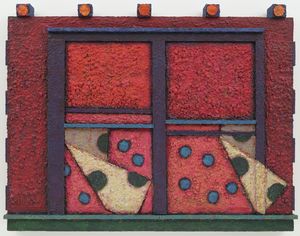Ralph Humphrey
Ralph Humphrey
Miejsce: Youngstown
Urodzony: 1932
Śmierć: 1990
Biografia:
Ralph Humphrey was an American abstract painter whose work has been linked to both Abstract Expressionism and Minimalism. He was active in the New York art scene in the 1960s and '70s. His paintings are best summarized as an exploration of space through color and structure. He lived and worked in New York, NY.
He is not to be confused with the percussionist Ralph Humphrey, best known for being the drummer of The Mothers Of Invention from 1973 until 1974.
Ralph Humphrey studied at Youngstown State University. He moved to New York in 1957 and immediately became a part of the art scene that was known, at the time, for Abstract Expressionism. He met artists such as Mark Rothko, Theodoros Stamos, Frank Stella, Robert Ryman, and Ellsworth Kelly, who would end up having a large influence on his work. Humphrey was a prominent member of the generation of artists who laid the groundwork for American art in the 1970s and 60s. From 1966 until his death in 1990, he taught painting in the graduate department at Hunter College.
Humphrey’s artistic style went through several phases and developments, which can be roughly outlined in the following way: monochromes from 1957–60; frame paintings 1961–65; shaped canvases 1967–70; constructed paintings 1971–1990. Throughout these phases, Humphrey kept a keen eye on color, light, and space while he moved between abstraction and representation. As Kenneth Baker explains in Art in America in 1984, “Each of his works defines an ideal viewing distance that can be discovered only by patient observation of the focus of the details, the resolution of the image and the proper relationship between body and object. Finding the apt distance from which to contemplate Humphrey’s new paints is thus not something you do discursively: it is an exercise in feeling your way silently towards a correct spatial interval.”
Reviewing Humphrey’s show at Tibor de Nagy in 1960, Donald Judd said, of his monochromes, “They are large, subtle and single-colored. This is Purism of a sort, in which generality does not contain variables but excludes them, in which the basic diagram or color, the only continuity, is exposed, here the essence of a confused sequence of perceptions.” Donald Judd also likened these canvases to the work of Kazimir Malevich, Piet Mondrian, and Josef Albers.
Neil A. Levine wrote in 1965 about Humphrey’s solo exhibition at Green Gallery, where he showed some of his frame paintings. Levine said, “His new work is serious and demanding. All the paintings are variations on one theme. The theme is, simply stated, an expansive, lightly brushed, large grey field…surrounded by a painted framing edge…” Here, Neil, too, references Albers, as well as TV screens, unfilled billboards, and Rothko.
Robert Pincus-Whitten reviewed Humphrey’s 1969 show at Bykert Gallery, where his shaped canvases were hung. Pincus-Whitten explains how Humphrey created “a luminous cosmos of fragile exhalations, painted on large squares or horizontal rectangles, softly turned at the corner and curved back into the stretcher.” These canvases are noteworthy, too, for their use of day-glow colors. At this time, his work becomes increasingly more atmospheric than his previous efforts; multi-colored wavy lines and sprayed colors replace solid geometric fields of single colors.
The last definable phase of his artistic style approaches representation at times, sometimes calling to mind an open window. These constructed paintings also border on sculpture, often coming ten inches out from the wall, directly confronting the viewer in real space. The paint, too, is considerably built up, giving the surface of the paintings considerable texture that was not previously seen in his work. Ellen Schwartz writes in 1977 about his show at John Weber, where his constructed paintings were still abstract: “Humphrey’s latest works, meditative rather than communicative, require the suspension of conscious efforts to grasp them before they will yield their secrets, which lay within ourselves all the while. The rich blue variegated surfaces are like blotters onto which we pour our own fantasies.” D Phillips, writing about his Willard Gallery show in 1982, explains how his constructed paintings are natural extensions of the earlier frame paintings: “Frames-within-frames have long provided the structural basis for Humphrey’s colorful designs; he has simply made his window allusion literal.” She explains, too, that these paintings are a step forward: “The shift does, however, bring greater variety and complexity to the artist’s constructions. There is a more explicit sense of space, of indoors and outdoors.” Beyond content, we see Humphrey using a brighter color palette and inserting vaguely figurative, whimsical patterns onto the surface. Yet, by the mid 1980s, the paintings return to a more ambiguous, abstract state.
Since his first solo exhibition at the Tibor de Nagy Gallery in New York City in 1959, Humphrey’s work has been the subject of 40 solo shows. During his lifetime, he had been represented by Green Gallery, Bykert Gallery, Andre Emmerich Gallery, Willard Gallery, and John Weber Gallery.
More...
Wikipedia link: Click Here

